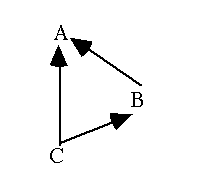05-830, User Interface Software, Spring, 2001
Lecture 8, February 19, 2001
Copyright © 2001 - Brad Myers
Previous
Lecture . . .
Next Lecture
Constraints
Show videos of constraint solvers.
Constraints
-
Relationships defined once and maintained by the system
-
Useful for keeping parts of the graphics together.
-
Typically expressed as arithmetic or code relationships among variables.
-
Variables are often the properties of objects (left, color)
-
Types:
-
"Dataflow" constraints; Choices:
-
Single-Output vs. Multi-output
-
Types: One-way, Multi-way, Simultaneous equations, Incremental, Special purpose
-
Cycles: supported or not
-
Others: AI systems, scheduling systems, etc.
One Way Constraints
-
Simplest form of constraints
-
D = F(I1, I2, ... In)
-
Often called formulas since like spreadsheets
-
Can be other dependencies on D

CurrentSliderVal = mouseX - scrollbar.left
scrollbar.left = window.left + 200
scrollbar.visible = window.has_focus
-
Not just for numbers:
mycolor = x.color
-
Implementations:
-
Just re-evaluate all required equations every time a value is requested
-
least storage, least overhead
-
Equations may be re-evaluated many times when not changed. (e.g,
scrollbar.left when mouse moves)
-
cycles:
file_position = F1(scrollbar.Val)
scrollbar.Val = F2(file_position)
-
Cannot detect when values change (for redraw)
-
Cache current values with each constraint; lazy eval
-
Example:
A = 10
B = A + 5
C = A * B
D = A + E
E = 20
F = D + C
-
now need to know when values become invalid and recalculate in right
order

-
two phases: invalidate and re-calculate
-
invalidate all values that depend on the changed value
-
recalculate only values that are demanded
-
data structures: depends-on-me, i-depend-on
-
may re-evaluate values that haven't changed unnecessarily when conditionals,
"max", etc.
-
can mark slots/objects that change
-
can detect cycles with a counter
-
Variations:
-
Multiple outputs
(D1, D2, ... Dm) = F(I1, I2, ... In)
-
Side-effects in the formulas
-
useful for creating objects
-
when happen?
-
what if create new objects with new constraints
-
cycles cannot be detected
-
Variables in the dependencies:
D = p^.left + 10
-
important innovation in Garnet we invented, now ubiquitous
-
supports feedback objects
-
supports loops:
D = Max(components^)
-
requires the dependencies be dynamically determined
-
Constant formula elimination
-
To decrease the size used by constraints
Two-Way (Multi-way) Constraints
-
From ThingLab (~1979)
-
Constraints are expressions with multiple variables
-
Any may be modified to get the right values
-
Example:
A.right = A.left + A.width - 1
-
Often requires programmer to provide methods for solving the constraint in
each direction:
A.left = A.right - A.width + 1
A.width = A.right - A.left + 1
-
Useful if mouse expressed as a constraint
-
Requires a planning step to decide which way to solve
-
Many systems compute plans and save them around since usually change same
variable repeatedly
-
In general, have a graph of dependencies, find a path through the graph
-
How control which direction is solved?
CurrentSliderVal = mouseX - scrollbar.left
-
"Constraint hierarchies" = priorities
-
constants, interaction use "stay" constraints with high priority
-
Dynamically add and remove constraints
-
Brad Vander Zanden's "QuickPlan" solver
-
Handles multi-output, multi-way cyclic constraints in O(n2) time instead
of exponential like previous algorithms
Simultaneous Equations
-
Required for parallel, perpendicular lines; tangency, etc.
-
Also for aggregate's size
-
Numerical (relaxation) or symbolic techniques
Incremental
-
Michael Gleicher's PhD thesis
-
Only express forward computations
-
Tries to get reverse by incrementally changing the forward computation in
the right direction using derivatives.
-
Supports interactions otherwise not possible
-
Produces smooth animations
Special: Animation Constraints in Amulet
-
Implemented using Amulet's constraint mechanism
-
When slot set with a new value, restores old value, and animates from old
to new value
-
Usually, linear interpolation
-
For colors, through either HSV or RGB space
-
For visibility, various special effects between TRUE and FALSE
Back to 05-830 main page
![]()
